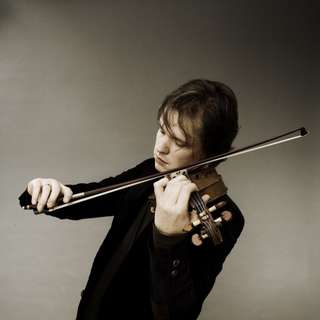|
Back
Prom 35: Focus on Denmark London
Royal Albert Hall
08/11/2010 -
György Ligeti: Ejszaka – Reggel – Lux Aeterna
Pyotr IlyichTchaikovsky: Violin Concerto
Rued Langgaard: Sfaerernes Musik
Jean Sibelius: Symphony No. 5
Inger Dam-Jensen (soprano), Henning Kraggerud (violin)
Danish National Vocal Ensemble, Danish National Concert Choir, Danish National Symphony Orchestra, Thomas Dausgaard (conductor) 
H. Kraggerud (Courtesy of Observatoriet / Simax Classics)
“Countless thorns: silence. My silence: the beating of my heart ... Night.”
So began tonight’s concert, with Ligeti’s setting of Sándor Weöres’s poem Ejszaka (Night). Introspective in feel, and with every word of the text described in the harmony and texture, it set the scene for what at times was quite an other-wordly evening of music. While this short piece and its companion, Reggel (Morning) show the young Ligeti exploring tone clusters and harmonic layering, they provided opportunity for the double choir to display a variety of tone colours, dynamic changes and rhythmic vocal effects.
As Night segued smoothly into Morning, so did Ligeti into Tchaikovsky. With only the tiniest of pauses, Thomas Dausgaard directed his attention from choir to orchestra, Henning Kraggerud appeared as if from nowhere, and before anyone had had time to even think of coughing, shuffling or clapping their hands, the concerto had started. This was more musically effective than one might have expected, perhaps due to the Ligeti ending on the notes D and A, and the violin concerto being in D major. Kraggerud’s sweet tone and technical virtuosity made for a light, dancing and joyful interpretation of the Tchaikovsky, which was matched perfectly by the orchestra. The tempi of the outer movements were generally on the fast side, which meant that sometimes cadences did not quite receive their full weight; however, this was quite made up for in energy and forward momentum. Kraggerud chose to linger over some of the lower-lying passages, and this was particularly effective, as were his invigorating double-stops. The orchestra were particularly impressive both in their rhythmic precision and handling of sharp tempo changes, and in the seamless blending of the different members of the woodwind section. After considerable applause, Kraggerud gave a delightful encore – his own solo Fantasy on a theme of Ole Bull.
The second section of the concert began with more choral Ligeti, this time one of his most famous works, Lux aeterna. Composed around a decade after Night and Morning, it exemplifies his matured micropolyphonic style. The ensemble had a warm, rich sound, but there were occasional moments of unevenness in tone and dynamic balance between voices. Again, Dausgaard launched straight from the Ligeti ‘overture’ into the next piece, this one the centrepiece of the evening – the UK premiere of Danish composer Langgaard’s fascinating 1918 work Sfaerernes Musik (Music of the Spheres). Requiring a solo soprano, two solo altos, a double choir, large orchestra, small ‘offstage’ orchestra and pipe organ, the half hour work is unclassifiable in genre, somewhere between tone poem, symphony and oratorio. Although one continuous movement, it is split into many short sections with titles such as Like sunbeams on a coffin decorated with sweet-smelling flowers, Soul of the World, and the final section, The End: Antichrist – Christ. From one section to another, the compositional style can vary greatly, sometimes tonal, sometimes not at all; sometimes hugely orchestrated, the next moment sparse; in one section not so far from elder contemporary Carl Nielsen, then in the next sounding startlingly like fragments of Steve Reich’s compositions from half a century later. The orchestra coped admirably with the demands, and although it is almost unfair on the rest to pick out individual musicians, the polyrhythms of the four sets of timpani were highly impressive, there was a lovely languid flute solo, and particularly effective was the antiphonal use of the performance space, with Inger Dam-Jensen’s soprano reverberating from high in the gallery. It may be hoped that the extremely positive reaction of the audience will encourage future performances of this work, aided by Dausgaard and the DNSO’s soon-to-be-released recording of it.
It makes for an interesting comparison to realise that Sibelius’s Fifth Symphony was written around the same time as Sfaerernes Musik. It is certainly one of his most well-loved of his works, and it sounded as if the orchestra love it too. Again, Dausgaard chose an energetic pace for the first movement, which really brought out the hemiola rhythms to full effect. As earlier, the level of precision was very high both within sections and between them, for example, in the dialogue between pizzicato strings and staccato winds. The energy and concentration persisted throughout, and their ‘Swan Hymn’ in the final movement was – as it ought to be – ridiculously uplifting. It might be thought that a three-hour concert would leave musicians tired out, but clearly not the Danish National Symphony Orchestra, who still had the energy for two short encores!
Carla Finesilver
|